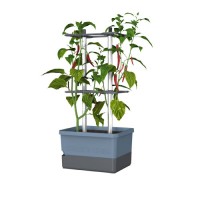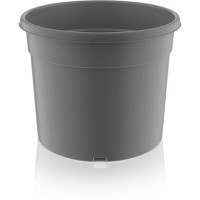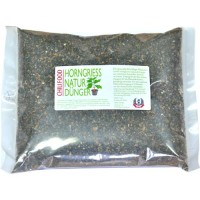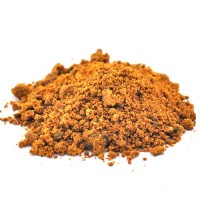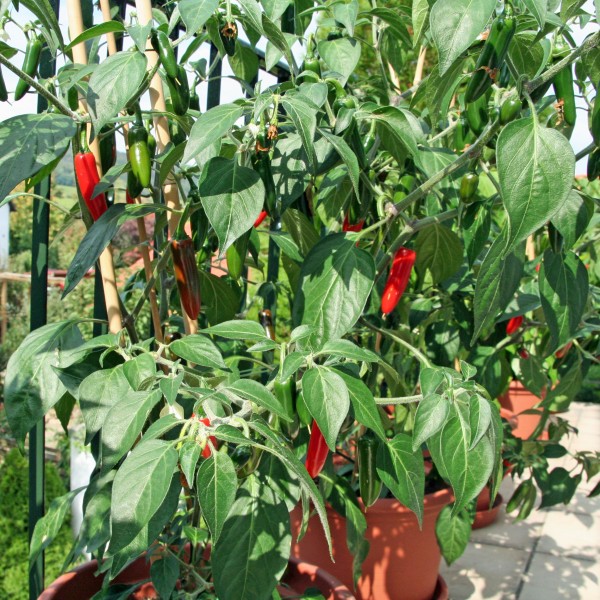
10 tips for healthy chilli plants
What do chilli plants need to grow well and produce a bountiful harvest?
Whether you grow your chillies from seed or buy pre-grown young plants, there are a few tricks you should definitely follow to ensure your plants grow nice and tall, stay healthy and produce lots of chillies:
1st tip - The right pot
The first decision with chillies is: growing in a pot or outdoor cultivation? We definitely recommend growing in a pot. Even the best location in the garden does not offer sun from morning to night. If the chilli plant grows in a pot, you can always move the plants to sunnier places.
The pots must be large enough for healthy root growth. This means at least 8 - 10 litres pot volume, better more. This corresponds to a pot with a diameter of 27 cm pot with a diameter of 27 cm or more. The perfect solution is the CHARLY Chili plant pot - specially developed for chilli and pepper plants. It has a support aid, automatic watering without waterlogging thanks to an integrated water tank and 10 litres of soil volume.
Tip 2: The right soil - the right fertiliser
When the chilli plants move into the large pot, it has proved useful to pre-fertilise the soil. First of all, it is important that you use good potting soil and not flower potting soil, as flower potting soil is usually pre-fertilised with chemical fertiliser that does not have food approval. After all, you don`t eat flowers. You should then prepare your good (organic) potting soil with organic slow-release fertiliser, which slowly releases the nutrients to the plants over a long period of time. For this purpose, horn meal and plant pellets are suitable. From fruit growth onwards, a regular liquid chili fertiliser is then used.
Tip 3 - Slowly acclimatise to the outdoors
Whether you have grown small chilli plants from seed or bought young plants: the plants must be adapted slowly to the outside. The plants should be put outside from April/May at the earliest, when the temperature is above 15°C during the day, but they still need to be brought inside overnight. Outside, especially direct sunlight can cause the tender plants to get sunburn. This can be recognised by silvery-grey spots on the leaves, which later stop growing and wither. Therefore, place them in a shady spot for only a few hours at the beginning so that they can slowly get used to the sunlight.
Tip 4 - Optimal fertilisation
In order for chilli plants to grow well and produce fruit, they need a good supply of nutrients: nitrogen for roots and leaves, phosphorus, potassium and magnesium for fruit development. If you want your plant to produce many flowers and fruits, you should not fertilise too much before flower development, otherwise the plant will put all its energy into the leaves. In general, pre-fertilising the soil with horn meal or plant pellets is sufficient. Otherwise, you should fertilise every 2 weeks with liquid fertiliser together with the irrigation water. As soon as the first fruits form, you should fertilise with liquid chili fertiliser once a week. As sweet peppers form much larger fruits, they may need even more fertiliser.
Tip 5 - The right location
Since chillies need a lot of warmth and sun, they grow best in a wind-protected, sunny spot with as many hours of sunlight as possible. Temperatures should not drop below 10°C at night. In greenhouses, temperatures quickly rise above 40°C in summer, then you have to ensure good ventilation. Especially for varieties with a long ripening period, growing the plants in pots is best, so that you can bring them indoors at night in autumn. Even a single night of frost will kill the plants. Robust varieties with a shorter ripening period can also be cultivated outdoors, but these also need a well-drained, loose soil and a wind-protected location with sun all day long - e.g. near a house wall, wall or protective hedge.
Tip 6 - Quick help against aphids and other pests
Especially small and indoor-grpowing chilli plants attract aphids, fungus gnats and whiteflies. As soon as you move them outside, sunlight, rain and wind usually solve the problem. To prevent infestation, it is helpful to either plant with neem soil or add neem cake to the soil. A closed layer of granules on the soil (perlite) also helps, especially against fungus gnats.
Neem can also be used in a spray solution if too many aphids show up on the leaves. To do this, mix a litre of water with 4 ml of neem oil and 1 ml of rimulgan (this emulsifier is necessary so that the oil can mix with water), pour it into a spray bottle and spray the plants with it once a day. (You can buy the ready-made mixture in our shop). This also works against spider mites, weevils and thrips.
A quick solution may be a spray solution made from garlic broth. For this, steep two chopped garlic cloves in a litre of boiling water until it has cooled down. Spray the plants with this once or several times a day.
Tip 7 - Water properly
Chillies need regular watering, but under no circumstances waterlogging, because the biggest enemy of chilli plants is "wet feet". A permeable soil is essential. If they are permanently standing in water, the roots start to rot and the plants die. In midsummer this is usually not a problem, but in autumn you really have to make sure that there is no water in the coaster.
Indoors, watering once or twice a week is enough. If they are outside in full sun and very warm temperatures, daily watering may also be necessary. It is best to check the moisture level of the soil (or use a soil moisture meter).
A little trick to get the plants to bloom a lot is to put them under stress for a short time when they are flowering. This also works with many other plants, as the stress causes the plant to try to reproduce before it dies. To achieve this, stop watering and fertilising when the very first flower buds appear. After two or three days of water stress, the plant will produce more flowers.
Even if the chillies are already large and only need to ripen, the plants can tolerate occasional drying out. This additionally increases the heat in the pods. However, be careful: you must not leave the leaves hanging for too long, even a chilli plant will not survive this. But if you want rather mild jalapenos, for example, just give them a little more water.
Water chillies - like tomatoes - only at the root ball, not over the leaves and fruit.
A coaster is important, because otherwise the nutrients are washed out. Then the taste also suffers.
Tip 8 - Pollination
Chillies usually flower throughout the summer, even if fruits are already ripening at the same time. If the plants stand outside, there is no need to do anything else, the flowers are then pollinated by wind and insects. A large variety of insects is basically helpful in the garden, because not only honey bees pollinate the flowers. A few tips on how to support insects in the garden can be found in our knowledge articles: Bee-friendly garden , Bee-friendly balcony , Water for insects, birds and co. .
If the chillies are indoors or in a greenhouse, it may be necessary to help by gently shaking the plants or using a small brush. In most cases, the air draft from regular ventilation is sufficient.
Tip 9 - Avoid cross-pollination
Chillies like to cross-pollinate, which is also the reason why there are so many different varieties. Even two varieties that stand next to each other on the balcony can cross-pollinate. This is especially noticeable if you have a very hot variety next to a mild variety, as the mild variety can become more hot. If you have grown the mild variety for the children, you should make sure that it has a distance of a few metres to the hot varieties.
In professional cultivation, separate greenhouses or fine gauze nets are used for outdoor cultivation.
10. tip - good support
Every chilli variety grows differently: e.g. the Habanada has a small, stocky, bushy growth, the Aji Amarillo by contrast grows strongly upwards before it starts to produce flowers. Especially the large varieties, but also those with large chillies or tender main shoots, need a support so that they are not so easily bent by the wind. On the balcony, for example, you can tie the main shoot to the railing or use sticks for support. A good solution is also the CHARLY Chili plant pot with integrated climbing aid.
Manufacturer
Name: | Chili-Food-Wissen |
Address: |
